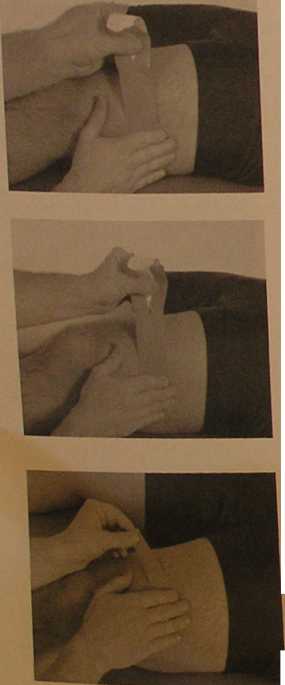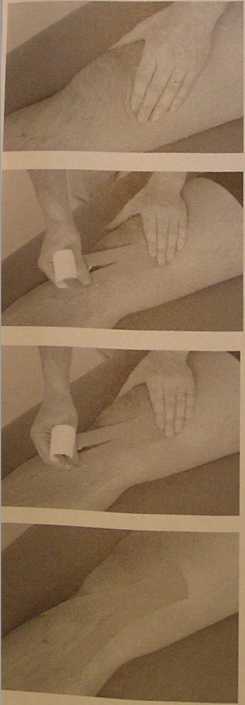P5140014
Fascła Correction Application Techniąue Useof faseta correction technigue to reposition fascia. tension on the base
Use of fascia correction techniąue to reposition fascia, with tension on the base. In this techniąue the practitioner is going to use the elastic qualities of the Kinesio Tex Tape to simulaie a manuał therapy techniąue. The elastic ąualities of the Kinesio Tex Tape will be applied usin® a "osdllation" motion in an attempt to reduce tension and adhesions between and within layeis of the fascia. This techniąue may not be as affective as using a manuał techniąue, however, if the practitioner is not skilled in a manuał techniąue this may still allow an option for treatmem

Begin by placing the base of Kineiso Y ] Strip approximately 1 /2 to 1 inch bleow the I area of fascia to be treated with no tension. ||
Apply light to moderate, 25-50% of avail. able tension to the tape in the direction fascia i correction is desired. Stretch should be lightl to moderate. The tape should be "oscillated* Minimal downward pressure should alsobe applied as the tape is being laid down. The downward pressure is not specifically intended to deepen the effect of the tape, j but only used to apply the Kinesio Tex Tape I during application, its function is to reduce | the "recoil" effect of the Kinesio Tex Tape. 1
Lay down the tails of the Kinesio Y Strip! down with no tension.
This techniąue can also be used to puli the fascia in the opposite direction. If the practi-1 tioner desires to move the fascia "away fromi an area the elastic ąualities of the Kinesio Tej Tape can be used to accomplish this goal.
Fascia Correction Application Techniąue Manuał fascia winding or myofascial release, tension on base.
Use of manuał fascia winding or myofascial release techniąue. Following the application of a manuał therapy techniąue position the fascia in the desired position prior to tape application. This techniąue can be used to either hołd fascia in desired position or limit the movement of fascia in an unwanted position. Use the Kinesio Strip to hołd the corrective posi tioning of the fascia.

Using manuał techniąue collect or correct fascia and soft tissue as appropriate
Place base of tape slightly above or below soft tissue whichhasbeengathered. Placing base of Kinesio Strip with no tension at start, hołd base to ensure no tension is added to the base.
Apply tension to the tape in the direction/ opposite direction fascia correction is desired. Moderate, 50% of available tension is applied with downward pressure should also be applied. The desired effect is to "hołd" to myofascial release techniąue in the desired position.
This can also be accomplished by using the tails to hołd the myofascial release as described in mechanical correction.
Lay the tails of the tape down with no tension. The tails should be splayed out to dissipate the created tension over as large of an area as possible.
Wyszukiwarka
Podobne podstrony:
46 (412) 3.5.2A. Specific technique to increase dorsal flexion of the occiput on the atlas. P sittin
47 (396) 3.5.2B. Specific techniąue to increase dorsal flexion of the occiput on the atlas. P sittin
48 (390) 3.5.2C. Specific technique to increase dorsal flexion of the occiput on the atlas. P supine
49 (372) 3.5.3A. Specific techniąue to increase dorsal flexion of the atlas on the axis. P. sitting.
50 (351) 3.5.3B. Specific techniąue to increase dorsal flexion of the atlas on the axis. P sitting.
51 (336) 3.5.3C. Specific techniąue to increase dorsal flexion of the atlas on the axis. P supine. S
P5140006 Table of Contents Introduction Corrective Application Techniques Mechanical Correction
P5140007 INTRODUCTFON The Corrective Application Techniques are a continuation in the development of
P5140012 Mechanical Correction Application Technigues Application of Y Technigue Application of Y Te
P5140018 Functional CorrectionTendon Correction Application Technigue Use of tendon correction techn
P5140019 Functional Correction Application Technigno Use of functional correction techniąue to assis
P5140016 Space Correction Application Tectinigii^g Fascia Corrections used for Space Correction Addi
P5140020 Lymphatic Correction The lymphatic corrcction is used to assist iii the removal of edema by
P5140097 Option Four: Application o( a modificd nierk calcorrection technique tensionon base, usinai
więcej podobnych podstron